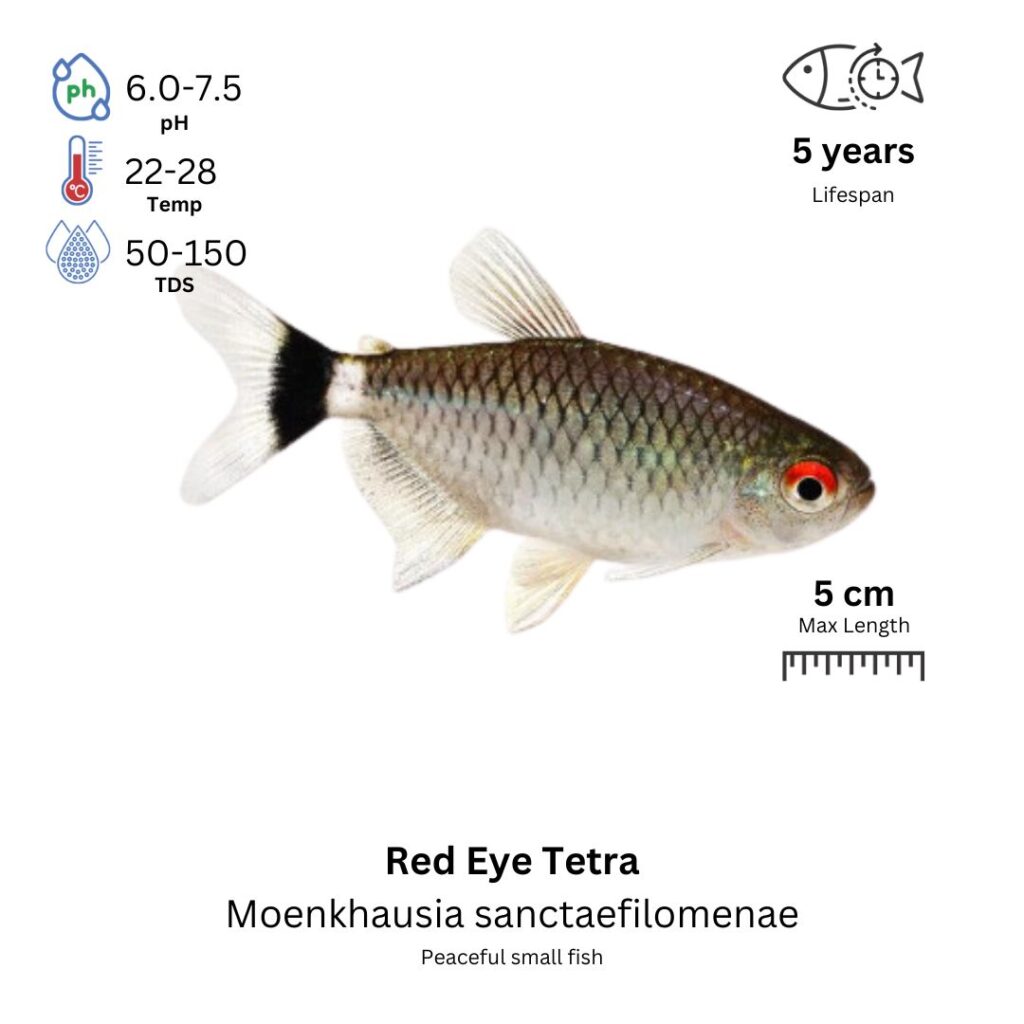Red Eye Tetra
Moenkhausia sanctaefilomenae

Description
The Red Eye Tetra is a small, striking fish that gets its name from the distinctive red hue around its eyes. The fish has a silvery body with a slight translucent or opalescent shine, complemented by dark markings near the tail and a subtle black stripe running along its body. Its eyes are its most notable feature, with a bright red or orange ring around the pupil, giving it a “red-eye” appearance. Males are often more colorful and smaller, while females tend to be rounder and slightly larger. Red Eye Tetras are peaceful, active, and social fish, known for their schooling behavior. They swim together in groups, which is when their bright coloration and natural behavior are most evident.
Habitat Origin
Native to the rivers and streams of South America, particularly in Brazil, Paraguay, and Argentina. They thrive in slow-moving waters with dense vegetation and submerged structures like roots and rocks. Red Eye Tetras are commonly found in waters that are slightly acidic, and they are accustomed to environments with moderate water flow and good oxygenation.
Aquarium
Ideal Number in Aquarium: At least 6 individuals, as they are schooling fish and feel more secure in groups.
Favorite Food

Red Eye Tetras are omnivores and will accept a variety of foods, including high-quality flake food, micro pellets, and live or frozen foods like brine shrimp, daphnia, and bloodworms. They will also graze on algae and small organic matter in the tank. A varied diet helps to maintain their health and vibrant coloration.
Behavior:
Red Eye Tetras are peaceful and social, thriving in groups. They are active swimmers and are typically found in the middle to upper regions of the tank. These fish are calm and non-aggressive, making them an excellent choice for community aquariums. Their schooling behavior is more pronounced when they are kept in groups of at least 6, where they interact with each other and swim in coordinated patterns. They are not fin-nippers and generally do well with other peaceful species.
Special Care:
Red Eye Tetras thrive in well-planted tanks with plenty of hiding spots such as plants, rocks, and driftwood. They prefer stable water conditions and regular water changes, as they are sensitive to poor water quality. A fine gravel or sandy substrate is ideal for them to forage and graze naturally. Moderate water flow is best, as it mimics the gentle current of their natural habitat. Keeping water parameters stable is essential for maintaining their health.
Compatibility with Other Fish:
Yes, Red Eye Tetras are compatible with a wide range of peaceful, small fish. They are ideal for community tanks with other tetras, rasboras, small catfish, and peaceful shrimp. Due to their peaceful nature, they can coexist with other non-aggressive species that occupy different levels of the tank. Avoid keeping them with larger or more aggressive fish, as they may become stressed or be bullied.
Breeding Setup
Setting up a dedicated breeding tank is highly recommended for Red Eye Tetras to control water parameters and prevent other fish from eating the eggs or fry. A 40-liter (10-gallon) tank is sufficient, offering enough room for swimming and egg scattering while remaining manageable for water quality. Maintain a pH of 6.0–7.0, temperature between 24°C and 28°C (75–82°F), and GH between 4–12 dGH. Use a gentle sponge filter to keep the water clean without disturbing the eggs. A bare-bottom tank or fine substrate is ideal, combined with live plants such as Java moss, Hornwort, and Anubias for egg adhesion and cover. Avoid harsh lighting—moderate or dim lighting is best to reduce stress and mimic their natural habitat.
Conditioning for Breeding
To get Red Eye Tetras ready to spawn, feed them a nutrient-rich diet consisting of high-quality flakes, live foods (brine shrimp, bloodworms, daphnia), and frozen protein-rich foods. This promotes reproductive health and boosts energy levels. Conduct weekly 25% water changes to keep water quality high and stable. Clean, oxygen-rich water supports breeding readiness and overall fish vitality.
Spawning Process
Red Eye Tetras are egg-scattering spawners and typically breed during early morning or late evening hours when lighting is low. Males will engage in courtship displays, chasing females and showing off their bright red and yellow eye markings. A female may lay 100–200 adhesive eggs that attach to plants, rocks, or the aquarium surface. Once eggs are laid, remove the adult fish immediately to prevent them from consuming the eggs, a common behavior in this species.
Fry Care
Eggs usually hatch in 24–36 hours, and the fry initially remain stationary, absorbing nutrients from their yolk sacs. When they become free-swimming, begin feeding infusoria, liquid fry food, or microscopic live foods like rotifers. As they grow stronger, introduce baby brine shrimp to meet their increasing nutritional needs. Maintain water quality with daily 10–15% water changes, and monitor levels of ammonia, nitrite, and nitrate closely. Stable conditions between 24°C and 28°C are critical for healthy fry development.
Important Notes
Red Eye Tetras reach sexual maturity at around 6–12 months of age. Males tend to be slimmer and more colorful, especially during courtship, while females are rounder when carrying eggs. A calm, stable tank environment is essential, as these tetras are sensitive to fluctuations in water conditions or aggressive tankmates. Keep the breeding tank stress-free and peaceful, without sudden changes, to maximize breeding success and fry survival.
